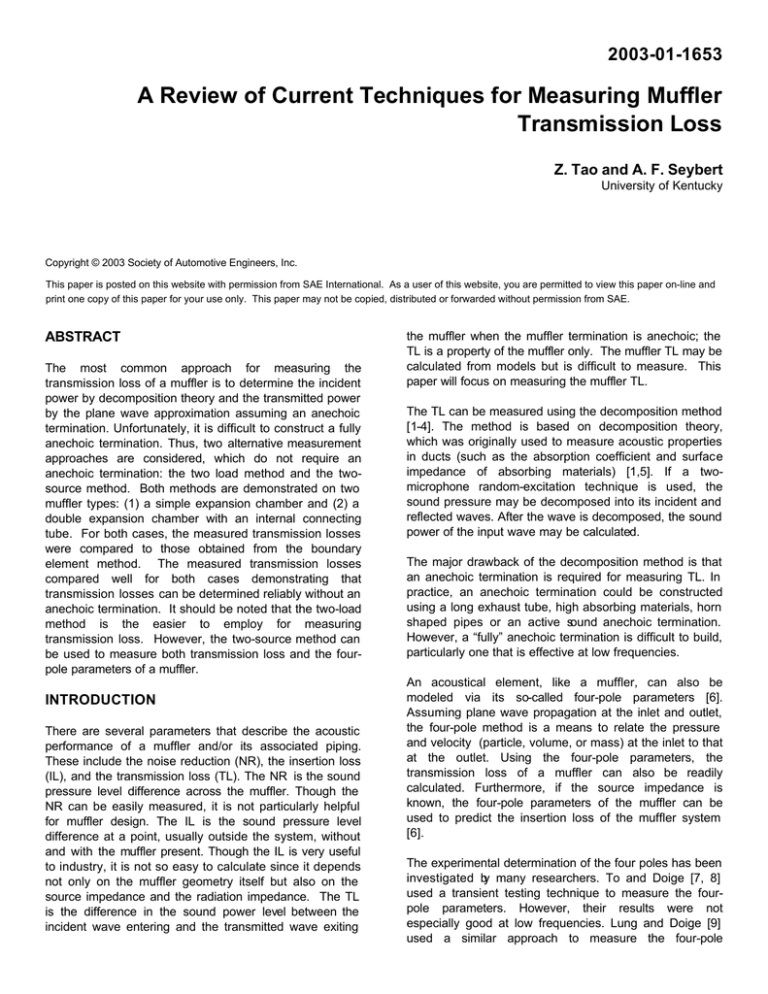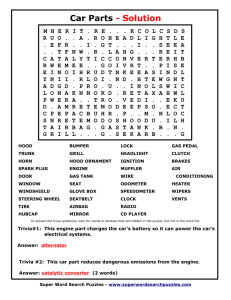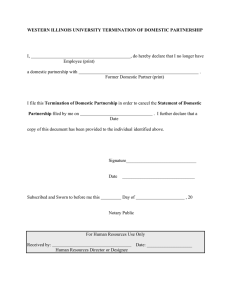A Review of Current Techniques for Measuring Muffler Transmission Loss 2003-01-1653
advertisement

2003-01-1653 A Review of Current Techniques for Measuring Muffler Transmission Loss Z. Tao and A. F. Seybert University of Kentucky Copyright © 2003 Society of Automotive Engineers, Inc. This paper is posted on this website with permission from SAE International. As a user of this website, you are permitted to view this paper on-line and print one copy of this paper for your use only. This paper may not be copied, distributed or forwarded without permission from SAE. ABSTRACT The most common approach for measuring the transmission loss of a muffler is to determine the incident power by decomposition theory and the transmitted power by the plane wave approximation assuming an anechoic termination. Unfortunately, it is difficult to construct a fully anechoic termination. Thus, two alternative measurement approaches are considered, which do not require an anechoic termination: the two load method and the twosource method. Both methods are demonstrated on two muffler types: (1) a simple expansion chamber and (2) a double expansion chamber with an internal connecting tube. For both cases, the measured transmission losses were compared to those obtained from the boundary element method. The measured transmission losses compared well for both cases demonstrating that transmission losses can be determined reliably without an anechoic termination. It should be noted that the two-load method is the easier to employ for measuring transmission loss. However, the two-source method can be used to measure both transmission loss and the fourpole parameters of a muffler. INTRODUCTION There are several parameters that describe the acoustic performance of a muffler and/or its associated piping. These include the noise reduction (NR), the insertion loss (IL), and the transmission loss (TL). The NR is the sound pressure level difference across the muffler. Though the NR can be easily measured, it is not particularly helpful for muffler design. The IL is the sound pressure level difference at a point, usually outside the system, without and with the muffler present. Though the IL is very useful to industry, it is not so easy to calculate since it depends not only on the muffler geometry itself but also on the source impedance and the radiation impedance. The TL is the difference in the sound power level between the incident wave entering and the transmitted wave exiting the muffler when the muffler termination is anechoic; the TL is a property of the muffler only. The muffler TL may be calculated from models but is difficult to measure. This paper will focus on measuring the muffler TL. The TL can be measured using the decomposition method [1-4]. The method is based on decomposition theory, which was originally used to measure acoustic properties in ducts (such as the absorption coefficient and surface impedance of absorbing materials) [1,5]. If a twomicrophone random-excitation technique is used, the sound pressure may be decomposed into its incident and reflected waves. After the wave is decomposed, the sound power of the input wave may be calculated. The major drawback of the decomposition method is that an anechoic termination is required for measuring TL. In practice, an anechoic termination could be constructed using a long exhaust tube, high absorbing materials, horn shaped pipes or an active sound anechoic termination. However, a “fully” anechoic termination is difficult to build, particularly one that is effective at low frequencies. An acoustical element, like a muffler, can also be modeled via its so-called four-pole parameters [6]. Assuming plane wave propagation at the inlet and outlet, the four-pole method is a means to relate the pressure and velocity (particle, volume, or mass) at the inlet to that at the outlet. Using the four-pole parameters, the transmission loss of a muffler can also be readily calculated. Furthermore, if the source impedance is known, the four-pole parameters of the muffler can be used to predict the insertion loss of the muffler system [6]. The experimental determination of the four poles has been investigated by many researchers. To and Doige [7, 8] used a transient testing technique to measure the fourpole parameters. However, their results were not especially good at low frequencies. Lung and Doige [9] used a similar approach to measure the four-pole parameters of uniform tubes, flare tubes and expansion chambers. They used a two-load, four-microphone approach, but the method was unstable when the two loads were not “sufficiently” different over the entire frequency range. The most accepted approach today is the approach developed by Munjal and Doige [10] who proposed a two-source method for measuring the four-pole parameters of an acoustic element or combination of elements. The method can also be used in the presence of a mean flow. This paper will compare the decomposition method, the two-source method and the two-load method. Examples will include (1) an expansion chamber and (2) a double expansion chamber with an internal connecting tube. The methods will be developed mathematically, and then applied to the examples. The measured results will be compared with boundary element method (BEM) results. By decomposition theory, the auto spectrum of the incident wave S AA is S AA = where S 11 and S 22 are the auto spectra of the total acoustic pressure at points 1 and 2, respectively; C12 and Q12 are the real and imaginary parts of cross spectrum between points 1 and 2; k is the wave number; and x12 is the distance between the two microphones [4]. The rms amplitude of the incident wave sound pressure p i can be founded from pi = S AA . The muffler TL is the acoustical power level difference between the incident and transmitted waves assuming an anechoic termination [11], i.e., Wi , Wt (1) where Wi is the incident sound power and Wt is the transmitted sound power. Generally, the transmitted sound power can be easily obtained by simply measuring the sound pressure at the outlet. The corresponding sound power can be related to the sound pressure if a plane wave with no reflection is assumed. However, the incident sound power is more difficult to measure due to the sound reflection from the muffler. As shown in Figure 1, for one-dimensional sound traveling along a duct, a standing wave develops when a change in the impedance is encountered at the muffler inlet. The sound pressure can be decomposed into its incident and reflected spectra, SAA and SBB, respectively. One way to decompose the wave is to use the two-microphone method and to separate the waves using decomposition theory [4]. Microphones Speaker SAA SBB 1 3 2 Anechoic termination x12 (2) (3) It follows that the sound power for each wave can be expressed in terms of the incident (p i) and transmitted (p t) rms pressure amplitudes as DECOMPOSITION METHOD TL = 10 log 10 S11 + S 22 − 2C 12 cos kx12 + 2Q12 sin kx12 , 4 sin 2 kx12 Muffler Figure 1 Setup of decomposition theory Wi = pi2 S ρc i (4) Wt = pt2 So , ρc (5) and respectively. In Equations (4) and (5), ρ is the fluid density, c is the speed of sound, and S i and S o are the muffler inlet and outlet tube areas, respectively. Inserting Equations (4) and (5) into Equation (1), the TL can be expressed as TL = 20 log 10 pi S + 10 log 10 i . pt So (6) A common error is to attempt to apply decomposition method to downstream of the muffler using a pair of microphones if the termination is not anechoic. This will not work as p t is not the same as the incident” wave sound pressure downstream. The TL for the expansion chamber shown in Figure 2 was measured by the decomposition method. An anechoic termination whose absorption coefficient is about 0.95 over 100-3000 Hz frequency range was used in the measurement. The TL results are compared to numerical results from the BEM (also shown in Figure 2). It is apparent that the measured results deviate from the BEM results over the whole frequency range. This is likely due to the termination not being anechoic enough. 50 Measured BEM TL (dB) 40 Ø 1.375 Ø6.035 30 Ø 1.375 p 2a 1 = A23 C ( p − A p ) 1a 12 2a 23 B12 8 20 p 3a B23 D D A 34 p 3a + (C34 − 34 34 ) p4 a D23 B B 34 34 (9) is developed where Aij, Bij, Cij and Dij are the four poles for acoustical element i–j; p ia is the sound pressure and via is the particle velocity at point i for Configuration a. 10 0 0 500 1000 1500 2000 Frequency (Hz) 2500 3000 Figure 2 Decomposition method vs. BEM (Muffler dimensions in inches) TWO-SOURCE METHOD [10] The two-source method is based on the transfer matrix approach. An acoustical element can be modeled by its four-pole parameters, as show in Figure 3. The transfer matrix is p1 A B p 2 v = C D v , 1 2 (7) One can see in Equation (9) that there are four unknowns, A23, B23, C23 and D23 , but only two equations. By moving the sound source to the other end (Configuration b in Figure 4), two additional equations are obtained and the four poles of element 3-2 can be evaluated. For Configuration b, one can then write p3b A23 v = − C 3b 23 −1 − B 23 p 2b 1 D23 = D23 v2b ∆ C 23 B 23 p2 b , (10) A23 v2b where ∆ is the determinant of the matrix, ∆= A23D23-B23C23 and minus sign “-” is from the change of the velocity direction in Configuration b. Source where p 1 and p 2 are the sound pressure amplitudes at the inlet and outlet, respectively; v1 and v2 are the particle velocity amplitudes at the inlet and outlet, respectively; and A, B, C and D are the four-pole parameters of the system. 1 2 Muffler 3 4 Configuration a 1 2 3 4 Source Acoustical element p1 2 1 v1 Configuration b p2 v2 Figure 4 Setup of two-source method Using the same approach as before, one can obtain another four-pole equation Figure 3 The four-poles When using the two-source method, two sound sources should be placed as shown in Figure 4. Configuration a will be examined first. Using the transfer matrix method, one can readily obtain four-pole equations for the straight tube elements between microphones 1-2 and 3-4. Similarly, the four-pole equation for element 2-3 which includes the muffler can be expressed as p2 a A23 v = C 2 a 23 B23 D23 p3 a v . 3a p3b p2b 1 = 1 D23 B 23 C12 A12 D12 A 12 − ) p1b − p2b ( ∆ 34 p4b − D34 p4 a ) ∆ C23 A23 ( B12 B34 ∆12 ∆ 12 B12 (11) where ∆12 =A12D12 - B12C12, ∆34 =A34D34 - B34C34. p ib is the sound pressure and vib is the particle velocity at point i for configuration b. Using both Equations (9) and (11), the four-pole parameters can be written as (8) where the subscript a refers to Configuration a in Figure 4. Combining the four-pole equations for 1-2, 3-4 and 2-3, the equation A23 = ∆ 34 ( H 32 a H 34 a − H 32 b H 34a ) + D34 ( H 32 b − H 32a ) ∆ 34 ( H 34 b − H 34 a ) B23 = B34 ( H 32a − H 32 b ) ∆ 34 ( H 34 b − H 34 a ) (12) (13) 2.24 ( H 31a − A12 H 32 a )(∆ 34H 34b − D34 ) − (H 31b − A12H 32b )(∆34 H 34a − D34 ) B12∆ 34 ( H 34b − H 34 a ) (14) (H 31a − H 31b ) + A12 (H 32b − H 32 a ) D23 = B34 , B12 ∆ 34 ( H 34b − H 34 a ) where (15) Ø1.375 Ø6.035 Ø1.375 Ø1.375 80 4.125 8 60 40 20 H ij = p j / pi , which are measured. 2.24 100 TL (dB) C 23 = Two-source Method BEM 0 Assuming that flow can be neglected, the four poles for elements 1-2 and 3-4 can be expressed as A12 C 12 0 500 1000 1500 2000 Frequency (Hz) 2500 3000 Figure 6 Two-source method vs. BEM (Muffler dimensions in inches) B12 cos kl12 = D12 j sin kl12 /(ρc ) jρ c sin kl12 , cos kl12 ∆12 = 1 (16) B34 = D34 jρc sin kl34 , coskl34 ∆ 34 = 1 (17) TWO-LOAD METHOD [9] and A34 C 34 cos kl34 j sin kl /(ρ c) 34 respectively. In Equations (16-17), l12 and l34 are the microphone spacings for elements 1-2 and 3-4, respectively. The TL can then be expressed in terms of the four-pole parameters and tube areas as [6] 1 B S TL = 20 log 10 A23 + 23 + ρc ⋅ C 23 + D23 + 10 log 10 i . 2 ρ c So (18) It should be noted that the two-source method can be implemented using only two microphones with random excitation. One can obtain all necessary transfer functions Hij by moving one microphone and using the other microphone as a reference. In Equation (9), one can see that there are four unknowns, A23, B23, C23 and D23, but there are only two equations. Instead of moving the sound source to the other end to get two additional equations, the same result can be obtained by changing the end condition, as shown in Figure 7. Changing the end condition effectively changes the impedance at the termination from Za to Zb. Equations (12 - 15) can be used again, and the four-pole parameters of element 2-3 can be obtained, as can the TL from Equation (18). In the two-load method, it is obvious that if two loads are very similar, the result will be unstable. Generally, two loads can be two different length tubes, a single tube with and without absorbing material, or even two different mufflers. In this research, two loads were achieved by a tube with and without absorbing material. Source 1 2 Test Element 3 4 The TL comparison is shown in Figure 5 for the expansion chamber used previously in Figure 2. The two-source method agreed especially well with the BEM results. The termination was the straight tube with absorbing material. Load 1 50 Two-source Method BEM 40 TL (dB) Za 1 2 Ø 1.375 Ø 6.035 3 4 Ø 1.375 Zb 30 8 20 Load 2 10 Figure 7 Setup of two-load method 0 0 500 1000 1500 2000 2500 3000 Frequency (Hz) Figure 5 Two-source method vs. BEM (Muffler dimensions in inches) Figure 6 shows another TL comparison for a double expansion chamber. Again, the measured results agreed with the BEM results. Figure 8 shows the TL comparison for the double expansion chamber shown. Excellent agreement was obtained using the two-load method and the two-source method. Figure 9 shows a comparison of the real part of the fourpole parameter A23 for the expansion chamber in Figure 9. Though the TL was measured accurately by the two-load method, the four-pole parameters are not as clean Two-source Method 100 2.24 Two-load Method 2.24 Ø 1.375 Ø 6.035 Ø 1.375 Ø 1.375 four-pole parameters of a muffler. It is also possible to reverse the muffler, which may be easier than moving the sound source. TL (dB) 80 ACKNOWLEDGMENTS 4.125 12 60 The authors would like to acknowledge the support of the Vibro-Acoustics Consortium at the University of Kentucky 40 20 REFERENCES 0 0 500 1000 1500 2000 Frequency (Hz) 2500 3000 Figure 8 Two-source method vs. two-load method (Muffler dimensions in inches) Real Part of A as those measured using the two-source method. This may be due to the two loads not being sufficiently different in 500-1500 Hz range. Further investigation is needed to clarify the reason for these differences. 6 4 2 0 -2 -4 -6 -8 -10 -12 Two-source Method Two-load Method Ø1.375 Ø6.035 Ø1.375 4 0 500 1000 1500 2000 2500 3000 Frequency (Hz) Figure 9 Real part of the four pole parameter A (Muffler dimensions in inches) CONCLUSIONS Three methods for measuring muffler TL have been discussed in this paper. The results indicated the limitations of the decomposition method in the absence of a good anechoic termination. Furthermore, the decomposition method does not lead to the four-pole parameters of the muffler; these are necessary for predicting the IL of the system. However, both the twosource and two-load methods accurately measured the muffler TL without the use of an anechoic termination. Theoretically, any termination could be used, but a termination with high reflection is not recommended. When the termination is highly reflective, the signal-tonoise ratio is low, and random errors can be large, which may contaminate the experimental results. The two-load method is easier to employ than the twosource method, since the sound source does not have to be moved. This assumes that the two loads are different enough. However, this study indicated that the two-source method might be the better choice for determining the 1. Seybert, A.F. and Ross, D.F., “Experimental Determination of Acoustic Properties Using a Twomicrophone Random Excitation Technique,” J. Acoust. Soc. Am., 61, 1362-1370 (1977). 2. Chung, J.Y. and Blaser, D.A., “Transfer Function Method of Measuring In-duct Acoustic Properties, I: Theory,” J. Acoust. Soc. Am, 68, 907-913 (1980). 3. Chung, J.Y. and Blaser, D.A., “Transfer Function Method of Measuring In-duct Acoustic Properties, II: Experiment,” J. Acoust. Soc. Am, 68, 914-921 (1980). 4. Seybert, A.F., ”Two-sensor Methods for the Measurement of Sound Intensity and Acoustic Properties in Ducts,” J. Acoust. Soc. Am, 83, 22332239 (1988). 5. ASTM standard, E1050-98, “Standard Test Method for Impedance and Absorption of Acoustical Material Using a Tube, Two Microphones and a Digital Frequency Analysis System,” (1998). 6. Munjal, M.L., Acoustics of Ducts and Mufflers, New York: Wiley-Interscience (1987). 7. To, C.W.S. and Doige, A.G., “A Transient Testing Technique for The Determination of Matrix Parameters of Acoustic Systems, 1: Theory and Principles,” Journal of Sound and Vibration, 62, 207-222 (1979). 8. To, C.W.S. and Doige, A.G., “A Transient Testing Technique for the Determination of Matrix Parameters of Acoustic Systems, 2: Experimental Procedures and Results,” Journal of Sound and Vibration, 62, 223233 (1979). 9. Lung, T.Y. and Doige, A.G., “A Time-averaging Transient Testing Method for Acoustic Properties of Piping Systems and Mufflers,” J. Acoust. Soc. Am, 73, 867-876 (1983). 10. Munjal, M.L. and Doige A.G., “Theory of a Two Source-location Method for Direct Experimental Evaluation of the Four-pole Parameters of an Aeroacoustic Element,” Journal of Sound and Vibration, 141(2), 323-333 (1990). 11. Beranek, L.L. and Vér, I.L., Noise and Vibration Control Engineering, John Wiley & Sons, Inc., 374 (1992). CONTACT For additional information concerning this article, please contact Dr. A. F. Seybert at (859) 257-6336 x 80645 or via email seybert@engr.uky.edu.



